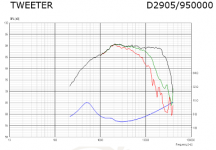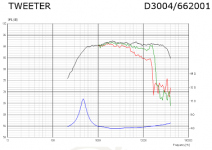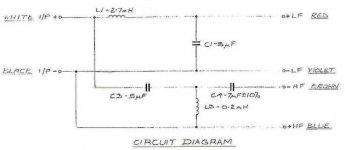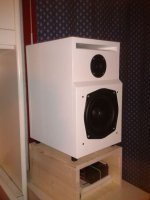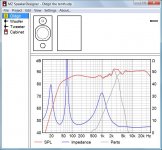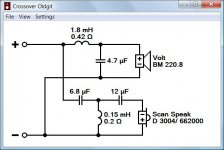Hi, first visit here although have viewed from afar from time to time.
First of all let me make this clear, I'm a music lover rather than an equipment tweaker so to speak. I can build and wire speakers but have little knowledge of electronics other than by the sound they produce.
So, I have a pair of Wilmslow Audio nearfield studio monitors that I built over 20 years ago now. I find them superb, but getting a little long in the tooth I need to try to get the top end a little more forward and as good sounding as I can.
They use the Volt BM220.8 bass/mid and at present Scanspeak D2905/9500 tweeters, the tweeters having been swapped out about 8 years ago when the originals failed. They were the closest possible and equal impedance to whatever it used originally.
I have been considering this for years and bought a pair of Scanspeak D3004/6620's some time ago.
I was told that although the existing are 6 ohm and the 6620's 4 ohm there would be no need for crossover alterations? Sensitivity is 90dB for the existing and 91.5 for the 6620's
Now I'm sceptical about that advice, am I right to be?
Given those values can anyone shed any light on a) what the effect is likely to be? and b) how it can be best rectified?
Given the existing crossovers are over 20 years old would the best option to be to have new made or would a simple like for like capacitor change suffice?
And I suppose I should ask who would be best placed to carry out such changes?
Please bear in mind the info I have given is simply from reading a few manf figures and a few forum articles, it doesn't imply much understanding on my part.
Thanks very much in advance.
First of all let me make this clear, I'm a music lover rather than an equipment tweaker so to speak. I can build and wire speakers but have little knowledge of electronics other than by the sound they produce.
So, I have a pair of Wilmslow Audio nearfield studio monitors that I built over 20 years ago now. I find them superb, but getting a little long in the tooth I need to try to get the top end a little more forward and as good sounding as I can.
They use the Volt BM220.8 bass/mid and at present Scanspeak D2905/9500 tweeters, the tweeters having been swapped out about 8 years ago when the originals failed. They were the closest possible and equal impedance to whatever it used originally.
I have been considering this for years and bought a pair of Scanspeak D3004/6620's some time ago.
I was told that although the existing are 6 ohm and the 6620's 4 ohm there would be no need for crossover alterations? Sensitivity is 90dB for the existing and 91.5 for the 6620's
Now I'm sceptical about that advice, am I right to be?
Given those values can anyone shed any light on a) what the effect is likely to be? and b) how it can be best rectified?
Given the existing crossovers are over 20 years old would the best option to be to have new made or would a simple like for like capacitor change suffice?
And I suppose I should ask who would be best placed to carry out such changes?
Please bear in mind the info I have given is simply from reading a few manf figures and a few forum articles, it doesn't imply much understanding on my part.
Thanks very much in advance.

The 9500s aren't so bad, so in the mean time why don't you try reducing the resistance in series with them. It should give you a feel for what can be done.
No, I don't find them bad, I just purchased the 6620's a couple of years ago, just never got round to changing due to my concerns. I'm just trying to get a feel for what will likely happen given those figures.
Ps, Just read some not all of your big sticky on crossover design, whoosh, over the top of my head, largely. I do have access to someone who for a small fee would carry out the work I'm sure, but I'd need to spec values etc. as I don't thing he has experience of crossover function.
Existing speakers are bi wired so without even opening the cabinets I could disable the volt unit by taking the links out and then listen to the existing and then fit the new units. I would be listening to the tweeter only so could maybe get an early view from that?
Both 104mm soft domes. Here's the homework which you need to do for any meaningful guess:
OLD D2905-950000 Le 0.07mH DCR 4.7R Ferrofluid
http://www.scan-speak.dk/datasheet/pdf/d2905-950000.pdf
NEW D3004-662001 Le 0.03mH DCR 3.0R Non-Ferrofluid
http://www.scan-speak.dk/datasheet/pdf/d3004-662001.pdf
I think I know what to do here, but, like AllenB, I'd want to see the tweeter filter first. It could be the ferrofluid is drying out after 20 years too. It goes sort of solid and gungy when the oil evaporates, leaving just dark ferrite dust.
OLD D2905-950000 Le 0.07mH DCR 4.7R Ferrofluid
http://www.scan-speak.dk/datasheet/pdf/d2905-950000.pdf
NEW D3004-662001 Le 0.03mH DCR 3.0R Non-Ferrofluid
http://www.scan-speak.dk/datasheet/pdf/d3004-662001.pdf
I think I know what to do here, but, like AllenB, I'd want to see the tweeter filter first. It could be the ferrofluid is drying out after 20 years too. It goes sort of solid and gungy when the oil evaporates, leaving just dark ferrite dust.
Attachments
Both 104mm soft domes. Here's the homework which you need to do for any meaningful guess:
OLD D2905-950000 Le 0.07mH DCR 4.7R Ferrofluid
http://www.scan-speak.dk/datasheet/pdf/d2905-950000.pdf
NEW D3004-662001 Le 0.03mH DCR 3.0R Non-Ferrofluid
http://www.scan-speak.dk/datasheet/pdf/d3004-662001.pdf
I think I know what to do here, but, like AllenB, I'd want to see the tweeter filter first. It could be the ferrofluid is drying out after 20 years too. It goes sort of solid and gungy when the oil evaporates, leaving just dark ferrite dust.
Hi all and thanks.
I took time out to call at WA today I obtained a copy of the crossover drawing/spec sheet.
They assure me that I won't hear any effect other than a sound level increase at the tweeter stage, they say they have supplied others succesfully and have demoed it in shop.
I must admit It's what I heard before and will approach it with some scepticism. A certain other major drive unit supplier doesn't share their view but won't comment further for obvious resons.
They do assure me that at 21 years old it will have poly caps fitted .
On the basis of no crossover schematic being available to me or any idea what the polarity should be, I think you should just wire up the new ones like the old ones and hope for the best!
They will likely sound brighter and a bit fuller at crossover. 1.5dB increase is audible. That's why Allen suggested a resistor or attenuator change. I don't suppose the impedance will go dangerously low, but it will be lower.
They will likely sound brighter and a bit fuller at crossover. 1.5dB increase is audible. That's why Allen suggested a resistor or attenuator change. I don't suppose the impedance will go dangerously low, but it will be lower.
Should have asked, is there anyone who can offer a design/upgrade service in my case?
Cheers.
Mate, we do it for nothing here! Given enough info. A 1.5dB level adjustment isn't rocket science. Trickier might be giving the tweeter a bit more slope at crossover, because it's flatter and lower impedance. Not too hard though.
On the basis of no crossover schematic being available to me or any idea what the polarity should be, I think you should just wire up the new ones like the old ones and hope for the best!
They will likely sound brighter and a bit fuller at crossover. 1.5dB increase is audible. That's why Allen suggested a resistor or attenuator change. I don't suppose the impedance will go dangerously low, but it will be lower.
Thanks, given that 1 think crossover is somewhere around 3khz, and that I have a sloping hearing response loss from 1.2k to 6k of a considerable magnitude, "a but brighter" is what I'm chasing.
To explain I have an audible threshold of 90 dB at 6k, can recall the values in the speech band.
Mate, we do it for nothing here! Given enough info. A 1.5dB level adjustment isn't rocket science. Trickier might be giving the tweeter a bit more slope at crossover, because it's flatter and lower impedance. Not too hard though.


Hmmm, opportunities. First let me say that if you have hearing loss, a 'correct' speaker response should let you hear things similarly to the way you hear them ordinarily. Still, why not change this if it's what you want.
The 9300 is similar to the 9500. If you want to try something simple, connect the tweeter to the other side of the 5.6 ohm resistor (same as connecting a wire across this resistor). If that doesn't give you what you want, try removing the 2.35 ohm resistor by connecting a wire over it, ie: running the amp straight to the capacitor. Let us know how it goes.
The 9300 is similar to the 9500. If you want to try something simple, connect the tweeter to the other side of the 5.6 ohm resistor (same as connecting a wire across this resistor). If that doesn't give you what you want, try removing the 2.35 ohm resistor by connecting a wire over it, ie: running the amp straight to the capacitor. Let us know how it goes.
Hmmm, opportunities. First let me say that if you have hearing loss, a 'correct' speaker response should let you hear things similarly to the way you hear them ordinarily. Still, why not change this if it's what you want.
The 9300 is similar to the 9500. If you want to try something simple, connect the tweeter to the other side of the 5.6 ohm resistor (same as connecting a wire across this resistor). If that doesn't give you what you want, try removing the 2.35 ohm resistor by connecting a wire over it, ie: running the amp straight to the capacitor. Let us know how it goes.
I'd like to say I fully understand which components you mean but even at this level I struggle with that drawing. Why are inductors shown the same as resistors schematically?
Definitely still suck it and see.
9300 was the original by the way, the 9500's replaced them 8-10 years back.l
Good idea sreten, wish I'd thought of that 
Maybe what you want to do is get yourself two jumper cables, just wires with a crocodile clip on each end. One per speaker would be all you need to begin with.
It's just that way because it was easier to draw.Why are inductors shown the same as resistors schematically?
Maybe what you want to do is get yourself two jumper cables, just wires with a crocodile clip on each end. One per speaker would be all you need to begin with.
I mostly get involved in the mostly demented and tirelessly repetitive threads at DIYAudio because something, "Je ne sais quoi" as the French say, interests me. 
This one is actually quite interesting. The Volt BM220-8 0hm is a modern recreation of your classic plastic polycone in the KEF B200 tradition.
Volt Loudspeakers | BM220.8 (8″)
It's quite well-behaved, as evidenced by the 1.8mH/4.7uf bass crossover with no shunt resistance. What's wrong with it is the awful choice of a soft-dome tweeter. Frankly these things stink. Er, IMO.
You can't correct hearing loss at HF with treble boost. It's simply inaccurate.
Much better, would be to use a ring radiator like the Vifa XT-25:
I say that having never heard one in my life. It's just theoretically better.
Below my 8" bass epiphany, the paper bass flat baffle KEF Celeste 3, a BW3/LR4 hybrid with negative polarity on the tweeter. And a physically time aligned KEF modification to the polycone 8" B200 with a Vifa XT-19 ring radiator to show there's many ways to skin a cat.
That Wilmslow design is rather good IMO, except for the choice of tweeter.
This one is actually quite interesting. The Volt BM220-8 0hm is a modern recreation of your classic plastic polycone in the KEF B200 tradition.
Volt Loudspeakers | BM220.8 (8″)
It's quite well-behaved, as evidenced by the 1.8mH/4.7uf bass crossover with no shunt resistance. What's wrong with it is the awful choice of a soft-dome tweeter. Frankly these things stink. Er, IMO.
You can't correct hearing loss at HF with treble boost. It's simply inaccurate.
Much better, would be to use a ring radiator like the Vifa XT-25:
An externally hosted image should be here but it was not working when we last tested it.
I say that having never heard one in my life. It's just theoretically better.
Below my 8" bass epiphany, the paper bass flat baffle KEF Celeste 3, a BW3/LR4 hybrid with negative polarity on the tweeter. And a physically time aligned KEF modification to the polycone 8" B200 with a Vifa XT-19 ring radiator to show there's many ways to skin a cat.
That Wilmslow design is rather good IMO, except for the choice of tweeter.
Attachments
Last edited:
I mostly get involved in the mostly demented and tirelessly repetitive threads at DIYAudio because something, "Je ne sais quoi" as the French say, interests me.
This one is actually quite interesting. The Volt BM220-8 0hm is a modern recreation of your classic plastic polycone in the KEF B200 tradition.
Volt Loudspeakers | BM220.8 (8″)
It's quite well-behaved, as evidenced by the 1.8mH/4.7uf bass crossover with no shunt resistance. What's wrong with it is the awful choice of a soft-dome tweeter. Frankly these things stink. Er, IMO.
You can't correct hearing loss at HF with treble boost. It's simply inaccurate.
Much better, would be to use a ring radiator like the Vifa XT-25:
An externally hosted image should be here but it was not working when we last tested it.
I say that having never heard one in my life. It's just theoretically better.
Below my 8" bass epiphany, the paper bass flat baffle KEF Celeste 3, a BW3/LR4 hybrid with negative polarity on the tweeter. And a physically time aligned KEF modification to the polycone 8" B200 with a Vifa XT-19 ring radiator to show there's many ways to skin a cat.
That Wilmslow design is rather good IMO, except for the choice of tweeter.
The problem is that a threshold of 85dba at 5-6K is also quite "simply inaccurate"
What I'm trying to do is get the best out of what I have and given the crossover is quite high, below the area I have real issues then a slight boost and a smoother teeter will hopefully help.
Let me put this into perspective from my hearing point of view, I disconnected the tweeter on 1 then both channels and listened, I can hardly tell. Hopefully that may help you understand my issues, theory is fine in a more perfect world, I'm afraid I don't live there anymore.
But thanks to all, I have a few ideas I will float after I've just tried a straight swap
Given the circumstances I assume you need to run the tweeter at full level. Attached my proposal for a new tweeter filter. Just a try, of course.
Cheers and thank you, all of these very helpful options are being collated and will be offered to the guy I know.
It's obvious this isn't my area of expertise, I'll put up a couple of photos tomorrow that shows where I fit in to DIY audio



You can't correct hearing loss at HF with treble boost. It's simply inaccurate.
Hi,
You can if its mainly you listening to the system, and hearing loss is mild,
but its no fun for everyone else if you overdo it, e.g for AV its a no-no.
rgds, sreten.
FWIW at modest levels my hearing, mid 50's goes pretty flat to 14KHz.
(I also have mild general hearing loss, but both are good for my age.)
Anything above that needs progressively louder levels to register, I
can't hear a mobile phone at 18KHz, younger people clearly can.
Personal headphones are a classic case of use what suits you.
Last edited:
- Status
- This old topic is closed. If you want to reopen this topic, contact a moderator using the "Report Post" button.
- Home
- Loudspeakers
- Multi-Way
- Changing out Scanspeak tweeters
